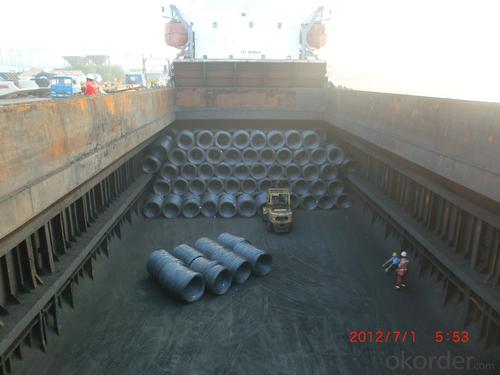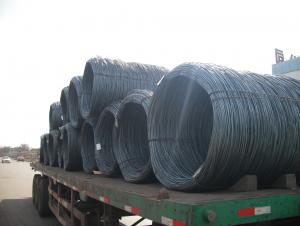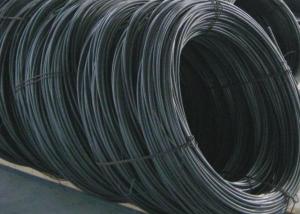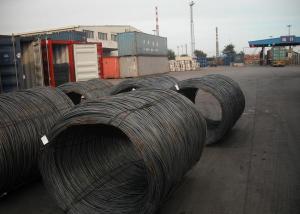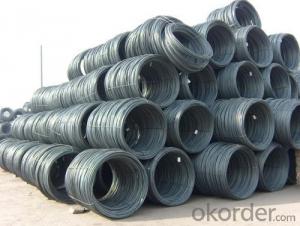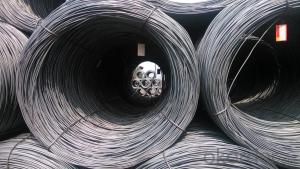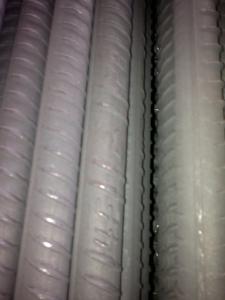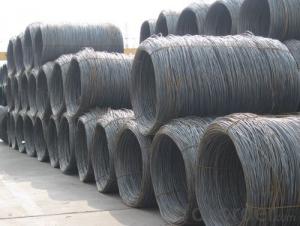High Quality Hot Rolled Wire Rod
- Loading Port:
- China Main Port
- Payment Terms:
- TT or LC
- Min Order Qty:
- -
- Supply Capability:
- -
OKorder Service Pledge
OKorder Financial Service
You Might Also Like
High Quality Hot Rolled Wire Rod Description:
OKorder is offering High Quality Hot Rolled Wire Rod at great prices with worldwide shipping. Our supplier is a world-class manufacturer of steel, with our products utilized the world over. OKorder annually supplies products to European, North American and Asian markets. We provide quotations within 24 hours of receiving an inquiry and guarantee competitive prices.
High Quality Hot Rolled Wire Rod Applications:
High Quality Hot Rolled Wire Rod are ideal for structural applications and are widely used in the construction of buildings and bridges, and the manufacturing, petrochemical, and transportation industries.
High Quality Hot Rolled Wire Rod Advantages:
OKorder's High Quality Hot Rolled Wire Rodare durable, strong, and resist corrosion.
High Quality Hot Rolled Wire Rod Main Features:
· Premium quality
· Prompt delivery & seaworthy packing (30 days after receiving deposit)
· Corrosion resistance
· Can be recycled and reused
· Mill test certification
· Professional Service
· Competitive pricing
Specifications of High Quality Hot Rolled Wire Rod:
Steel Grade: Q195/235, SAE1006-1018B Standard: ASTM, GB
Diameter: 5.5mm, 6.5mm, 7mm,8mm,9mm,10mm,12mm,14mm
Type: in coil, coil weight around 2MT Alloy or Not: Alloy
Technique: Hot Rolled Place of Origin: China Mainland
Surface: round, no twisted, light and smooth Brand Name: HSKY
Chemical Composition: (Please kindly find our chemistry of our material based on Q195、Q235A and Q235B as below for your information)
Trademark | Rank | Chemical composition (quality score) % | ||||||
C | Si | Mn | S | P | ||||
| ||||||||
| ≤ |
| ≤ | ≤ | ||||
Q195 |
| 0.06-0.12 | 0.30 | 0.25 | 0.050 | 0.045 | ||
Q235 | A | 0.14-0.22 | 0.30 | 0.30-0.65 | 0.050 | 0.045 | ||
Q235 | B | 0.12-0.20 | 0.30 | 0.30-0.70 | 0.045 | 0.045 | ||
Usage and Applications of Hot Rolled Wire Rod:
After hot-rolled the products shaped into coil and delivery as finished product, including round, square, rectangular, hexagonal and so on. Since most of the products are round, it is generally called wire rod. Carbon steel wire rod is widely used in construction and manufacturing. Carbon steel wire rod is mainly used for reinforcement of reinforced concrete and welded structure or reprocessed (roberts , nail, etc.) materials, especially used to produce wire drawing, welding electrode, nails, spring, electronic, precise machinery parts and so on.
Packaging & Delivery of Hot Rolled Wire Rod:
Packaging Detail: products are packed in coil, each coil weight around 2 MT, and then shipped by container or bulk vessel
Delivery Detail: within 45 days after received deposit or LC.
Label: to be specified by customer, generally, each bundle has 1-2 labels
Trade terms: FOB, CFR, CIF
FAQ:
Q1: Why buy Materials & Equipment from OKorder.com?
A1: All products offered byOKorder.com are carefully selected from China's most reliable manufacturing enterprises. Through its ISO certifications, OKorder.com adheres to the highest standards and a commitment to supply chain safety and customer satisfaction.
Q2: How do we guarantee the quality of our products?
A2: We have established an advanced quality management system which conducts strict quality tests at every step, from raw materials to the final product. At the same time, we provide extensive follow-up service assurances as required.
Q3: How soon can we receive the product after purchase?
A3: Within three days of placing an order, we will begin production. The specific shipping date is dependent upon international and government factors, but is typically 7 to 10 workdays.
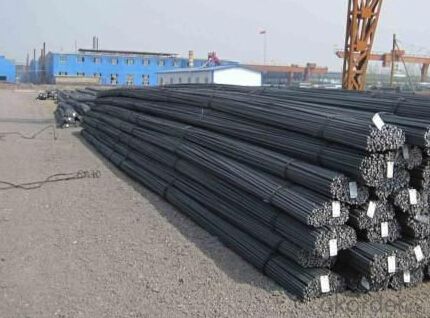
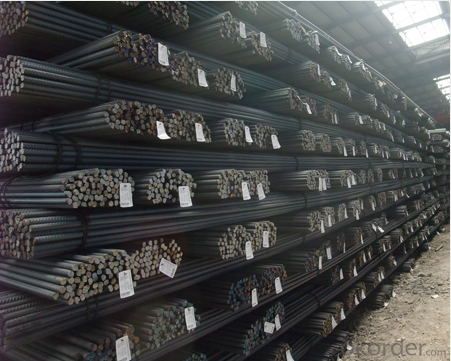
- Q: How is steel wire rod used in the manufacturing of paper clips?
- Steel wire rod is used in the manufacturing of paper clips as it provides the necessary strength and flexibility required to form the clip shape. The rod is first cut into small lengths and then bent into the classic paper clip design using specialized machinery. This process ensures that the paper clips are durable and can securely hold papers together.
- Q: What are the cost considerations of steel wire rod?
- The cost considerations of steel wire rod include the price of raw materials, production and processing costs, transportation and logistics expenses, market demand and competition, and any additional charges or tariffs. Factors such as the quality, grade, diameter, and quantity of steel wire rod can also affect the overall cost.
- Q: What are the different types of wire mesh filters made from steel wire rod?
- The different types of wire mesh filters made from steel wire rod include woven wire mesh filters, welded wire mesh filters, and expanded metal mesh filters.
- Q: What are the different hardness measurement methods for steel wire rod?
- There are several different methods used to measure the hardness of steel wire rods. These methods include: 1. Rockwell Hardness Test: This test measures the depth of penetration of an indenter into the material under a specified load. The Rockwell hardness scale is commonly used for steel wire rods due to its simplicity and versatility. 2. Brinell Hardness Test: In this test, a hardened steel ball is pressed into the surface of the wire rod under a known load. The hardness is determined by measuring the diameter of the indentation left by the ball. 3. Vickers Hardness Test: This test uses a square-based pyramid-shaped diamond indenter to make an indentation on the surface of the wire rod. The size of the indentation is measured and used to calculate the hardness. 4. Knoop Hardness Test: Similar to the Vickers test, the Knoop test uses a rhombic-based pyramid-shaped diamond indenter. It is particularly suitable for measuring the hardness of thin materials. 5. Microhardness Testing: This method involves measuring the hardness of small regions or specific areas on the wire rod using a microscope. It is often used to study the microstructure and hardness variations within the material. It is important to note that each hardness measurement method has its own advantages and limitations. The choice of method depends on the specific requirements and characteristics of the steel wire rod being tested.
- Q: What are the factors that affect the mechanical properties of steel wire rod?
- The mechanical properties of steel wire rods are influenced by several factors. 1. Composition: The chemical composition of steel, including the presence of alloying elements such as carbon, manganese, silicon, and others, determines its mechanical properties. Different compositions result in varying levels of strength, toughness, and ductility. 2. Microstructure: The microstructure of steel, including grain size and distribution, also affects its mechanical properties. Fine-grained steels generally exhibit higher strength and improved toughness compared to coarser-grained ones. Heat treatment processes can be used to control the microstructure and enhance desired properties. 3. Heat treatment: Various heat treatment processes, such as annealing, quenching, and tempering, can significantly alter the mechanical properties of steel wire rods. These processes modify the structure and hardness of the material, providing desired levels of strength, hardness, and ductility. 4. Processing conditions: The mechanical properties of steel wire rods can also be influenced by the processing conditions during manufacturing. Factors such as the temperature, rate of cooling, and deformation applied during rolling, drawing, or extrusion processes can affect the final properties. Proper control of these parameters is crucial to achieving the desired mechanical properties. 5. Surface finish: The surface condition of steel wire rods can impact their mechanical properties. A smooth and clean surface is generally preferred as it reduces the likelihood of cracks, improves fatigue resistance, and enhances overall performance. 6. Impurities and defects: The presence of impurities, such as sulfur, phosphorus, and non-metallic inclusions, can negatively impact the mechanical properties of steel wire rods. Similarly, manufacturing defects like cracks, voids, and inhomogeneities can weaken the material and reduce its strength. 7. Environmental factors: The environment in which steel wire rods are used can affect their mechanical properties. Variables such as temperature, humidity, exposure to corrosive substances, and mechanical loading conditions can all influence the material's behavior, including its strength, ductility, and corrosion resistance. In conclusion, the mechanical properties of steel wire rods are influenced by factors such as composition, microstructure, heat treatment, processing conditions, surface finish, impurities, defects, and environmental factors. Understanding and controlling these factors are crucial in producing steel wire rods with desired mechanical properties for various applications.
- Q: What are the trade regulations for steel wire rod?
- Trade regulations for steel wire rod vary depending on the country or region. However, some common regulations may include quality standards, labeling requirements, and tariffs or quotas imposed to protect domestic steel industries. It is important to consult the specific regulations set by the importing and exporting countries to ensure compliance and smooth trade operations.
- Q: What are the factors that influence the mechanical properties of steel wire rod?
- The mechanical properties of steel wire rods can be influenced by several factors. These factors encompass: 1. Composition: The mechanical properties of steel are determined by its chemical composition, including the presence of alloying elements. Alloying elements like carbon, manganese, silicon, and others can affect the wire rod's strength, hardness, and ductility. 2. Microstructure: The mechanical properties of steel are greatly influenced by its microstructure, which is determined by factors like cooling rate and heat treatment. The arrangement of grains, impurity presence, and size and distribution of precipitates can all impact the wire rod's strength, toughness, and other properties. 3. Processing conditions: During the production of wire rods, the mechanical properties can be significantly affected by processing conditions such as temperature, cooling rate, and rolling conditions. Controlled cooling rates, for example, can result in a fine-grained microstructure that enhances the wire rod's strength and toughness. 4. Heat treatment: Heat treatment processes like annealing, quenching, and tempering can further modify the mechanical properties of steel wire rods. These processes refine the microstructure, relieve internal stresses, and improve the wire rod's strength, hardness, and ductility. 5. Surface finish: The mechanical properties of the wire rod can also be influenced by its surface finish, including factors like scale, decarburization, and surface defects. A smooth and clean surface contributes to better fatigue resistance and overall mechanical performance. 6. Size and shape: The mechanical properties of wire rods can be influenced by their size and shape, including diameter and cross-sectional profile. Thicker rods tend to have higher strength but lower ductility, while thinner rods may exhibit higher ductility but lower strength. 7. Environmental conditions: The mechanical properties of steel wire rods can also be affected by environmental conditions in which they are used. Factors like temperature, humidity, and exposure to corrosive substances can impact the wire rod's strength, toughness, and corrosion resistance. Considering these factors is crucial when selecting or designing steel wire rods for specific applications, as they greatly impact the performance and reliability of the final product.
- Q: What are the common applications of high-strength steel wire rod?
- High-strength steel wire rods are commonly used in a variety of applications, including construction, automotive, aerospace, and manufacturing industries. They are often used for reinforcement in concrete structures, such as bridges and buildings, due to their superior strength and durability. In the automotive industry, high-strength steel wire rods are utilized for the production of suspension systems, seat frames, and safety components. They are also essential in the aerospace sector for manufacturing aircraft components and engines. Additionally, high-strength steel wire rods find applications in manufacturing processes, such as wire mesh, springs, and cables, due to their ability to withstand high stress and resist deformation.
- Q: How is steel wire rod used in the production of wire rods for reinforcement?
- Steel wire rod is used in the production of wire rods for reinforcement by being hot rolled into thin, long and continuous strands. These wire rods are then further processed and cold drawn to achieve the desired strength and size, which makes them ideal for reinforcing concrete structures. The wire rods are subsequently cut into smaller lengths and formed into various shapes such as bars, meshes, or grids, which are then embedded within concrete to enhance its tensile strength and overall stability.
- Q: What are the major steel wire rod trade shows and conferences?
- Some major steel wire rod trade shows and conferences include Wire & Cable India, Wire China, Wire South America, and the International Wire & Cable Symposium. These events provide a platform for industry professionals to showcase their products, network, and stay updated on the latest developments in the steel wire rod sector.
Send your message to us
High Quality Hot Rolled Wire Rod
- Loading Port:
- China Main Port
- Payment Terms:
- TT or LC
- Min Order Qty:
- -
- Supply Capability:
- -
OKorder Service Pledge
OKorder Financial Service
Similar products
Hot products
Hot Searches
Related keywords





